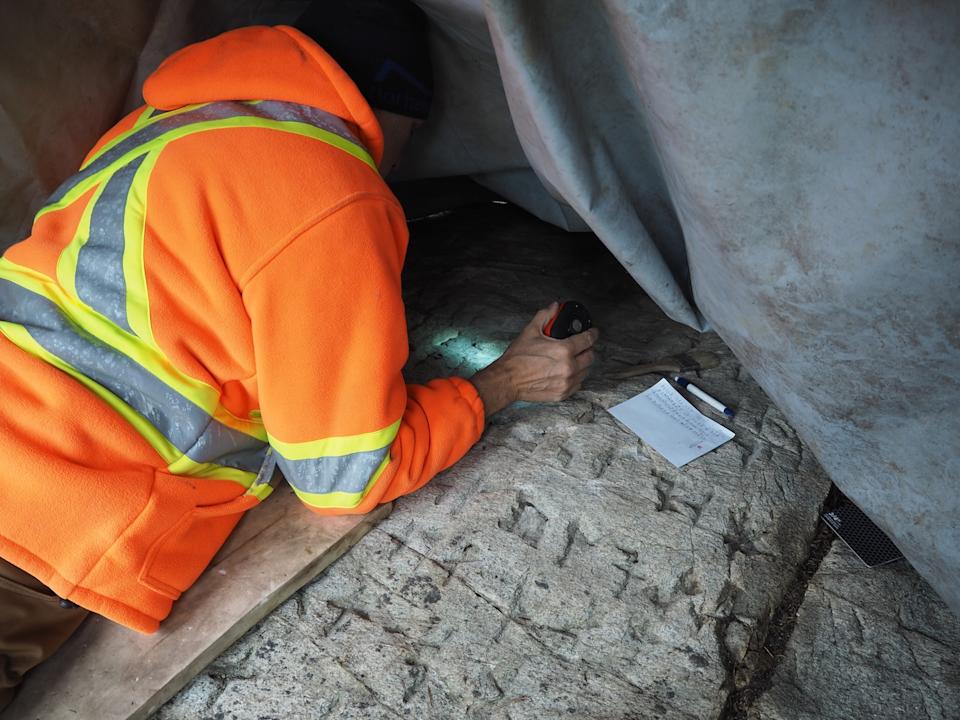The Futhark Prayer: A 250-Symbol Mystery Carved in the Canadian Wilderness
Archaeologists have been baffled by a surprising find in the Canadian wilderness, a massive slab of bedrock etched with a hand-carved rendition of the full Lord’s Prayer. The religious text is not inscribed in French or English, but rather composed of over 250 symbols from the oldest known runic alphabet, the Futhark.

The perplexing discovery was made completely by chance when a tree fell near the town of Wawa, not far from Lake Superior. Closer inspection revealed that someone had etched 255 runes into a roughly 4 by 5 foot section of the slab, along with a detailed illustration of a boat and 16 additional runic signs and 14 X markings.
Photos of the site soon reached Ryan Primrose, president of the Ontario Center for Archaeological Education, who was immediately stunned by the images. “It’s certainly among the least expected discoveries of my career. It’s absolutely fascinating,” he told CBC.
The analysis of the mysterious stone inscription took years of planning and cooperation. Primrose contacted Henrik Williams, an emeritus professor of runology at Uppsala University, who helped arrange a visit to the site in October. Williams spent three hours scouring the rock for clues to decipher it, eventually determining that the message was written with Futhark alphabetic runes.
Futhark was first developed and used by Germanic peoples between the 2nd and 8th centuries CE and eventually evolved into a simplified version adopted by Scandinavians. The knowledge of how to read its original iteration died out by the High Middle Ages (around 1000-1300 CE), until Norwegian scholar Sophus Bugge finally succeeded in deciphering the long-lost language in 1865.

Despite the Futhark runes being a European fascination, historical documents confirm that Hudson’s Bay Company stationed Swedish workers at trading posts across Canada beginning in the 1800s. And it just so happens that Bureus’ runic Lord’s Prayer was republished during the 19th century. Primrose and colleagues now theorize that a Hudson’s Bay Company employee—or employees—are responsible for the labor-intensive project that likely took days, if not weeks to complete.
The conservationists are now working with the local landowners on a leasehold to turn their archaeological discovery into a public heritage site that includes a protective structure to guard it against the elements. Primrose confessed to being “a little disappointed” that the artifact is likely only a couple centuries old, but plenty of questions still surround the find. Was the site a place for religious gatherings, or the devotional effort of one person? Prior to its exposure, the bedrock also lay under multiple inches of soil. With no other artifacts found nearby, was the prayer intentionally buried?
“The mystery doesn’t fade just because it’s younger than we hoped,” said Primrose. “Why was it carved here? Why this text? There are no answers. And mysteries always draw people in.”
The discovery of the 250-symbol Futhark Prayer carved in Canada's wilderness is a poignant revelation not only into an ancient pagan tradition, but also as evidence that humankind’ s spiritual quest for connection transcends even remote landscapes and time.
Exploring the mystical inscription of The Futhark Prayer, a 250-symbol carving dug out amidst Canada's rugged wilderness reveals an otherworldly harmony between nature and ancient Norse spirituality.
The unfolding of The Futhark Prayer, a 250-symbol mystery etched in the Canadian wilderness like an ancient call to adventure into mythical times and spaces beyond reality's borders.
The Futhark Prayer, with its intricate 250-symbol mystery carved in the Canadian wilderness, is an astonishing blend of ancient tradition that transcends time and nature to bloom like a rare flower against unforgiving landscapes.
The compelling story of 'The Futhark Prayer: A 250-Symbol Mystery Carved in the Canadian Wilderness' is a captivating exploration into an ancient runic ritual, shrouded by centuries and providing insightful glimpses to today’s curious minds.














